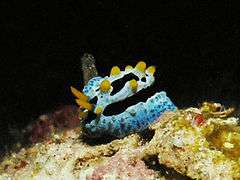Phyllidia coelestis
Phyllidia coelestis is a species of sea slug, a sacoglossan, a shell-less marine gastropod mollusc in the family Phyllidiidae.[2]
| Phyllidia coelestis | |
|---|---|
 | |
| at Bunaken, North Sulawesi | |
| Scientific classification | |
| Kingdom: | |
| Phylum: | |
| Class: | |
| (unranked): | clade Heterobranchia clade Euthyneura clade Nudipleura clade Nudibranchia clade Euctenidiacea clade Doridacea |
| Superfamily: | |
| Family: | |
| Genus: | |
| Species: | Phyllidia coelestis |
| Binomial name | |
| Phyllidia coelestis | |
Distribution and habitat
This species occurs in the tropical Indo/West-Pacific. It lives on the external slope of coral reefs, on top of the reef and in the lagoon, also down to 30 m in depth. Found in the western Pacific Ocean, South China Sea, Timor Sea and across the Indian Ocean to South Africa.
Description
This sea slug is up to 6 cm in length. The body is elongated and slug-shaped. The mantle has a grey-blue background color; the margin is covered with many small tubercles. Bigger tubercles that are yellow capped, run along the median line.
There are also three black longitudinal lines. Two of them are on each side of the mantle, and one on a median line ending on the anterior part as a "Y". This particular line shape constitutes a distinctive element to identify this species.
In this species the rhinophores possess lamellae, and are yellow in color.
Behaviour
This species is benthic and diurnal. Because of its aposematic colors, it is able to crawl around in the daylight to feed. Phyllidia coelestis has a diet based on sponges.
References
- Brunckhorst D.J. (1993) The systematics and phylogeny of phyllidiid nudibranchs (Doridoidea). Records of the Australian Museum suppl. 16: 1-108.
- Bouchet, P.; Gofas, S. (2012). Phyllidia. Accessed through: World Register of Marine Species at http://www.marinespecies.org/aphia.php?p=taxdetails&id=138347 on 2012-06-07
- P.L. Beesley, G.J.B. Ross & A. Wells,"Mollusca-The southern synthesis", vol.5,CSIRO,1998,ISBN 0-643-05756-0
- David Behrens, "Nudibranch behaviour", Newworld Publication INC., 2005, ISBN 978-1878348418
- Gary Cobb & Richard Willan, "Undersea jewels- a colour guide to nudibranchs", Australian Biological Resources Study, 2006, ISBN 0642568472
External links
- Sea Slugs Forum, Phyllidia coelestis
- Worms, Phyllidia coelestis
- Seaslugs,Phyllidia coelestis
- Photos of Phyllidia coelestis on Sealife Collection